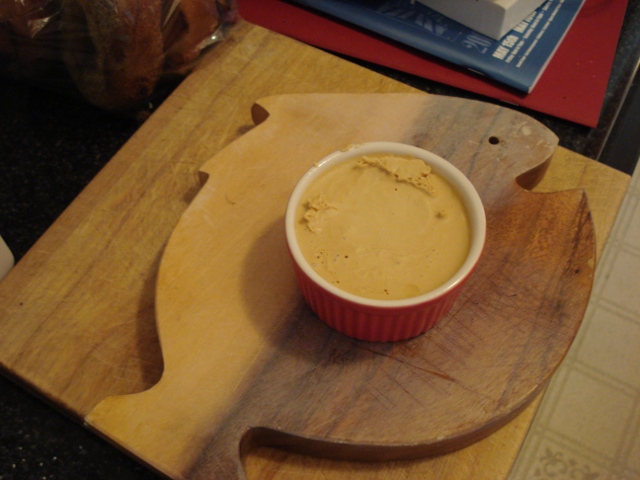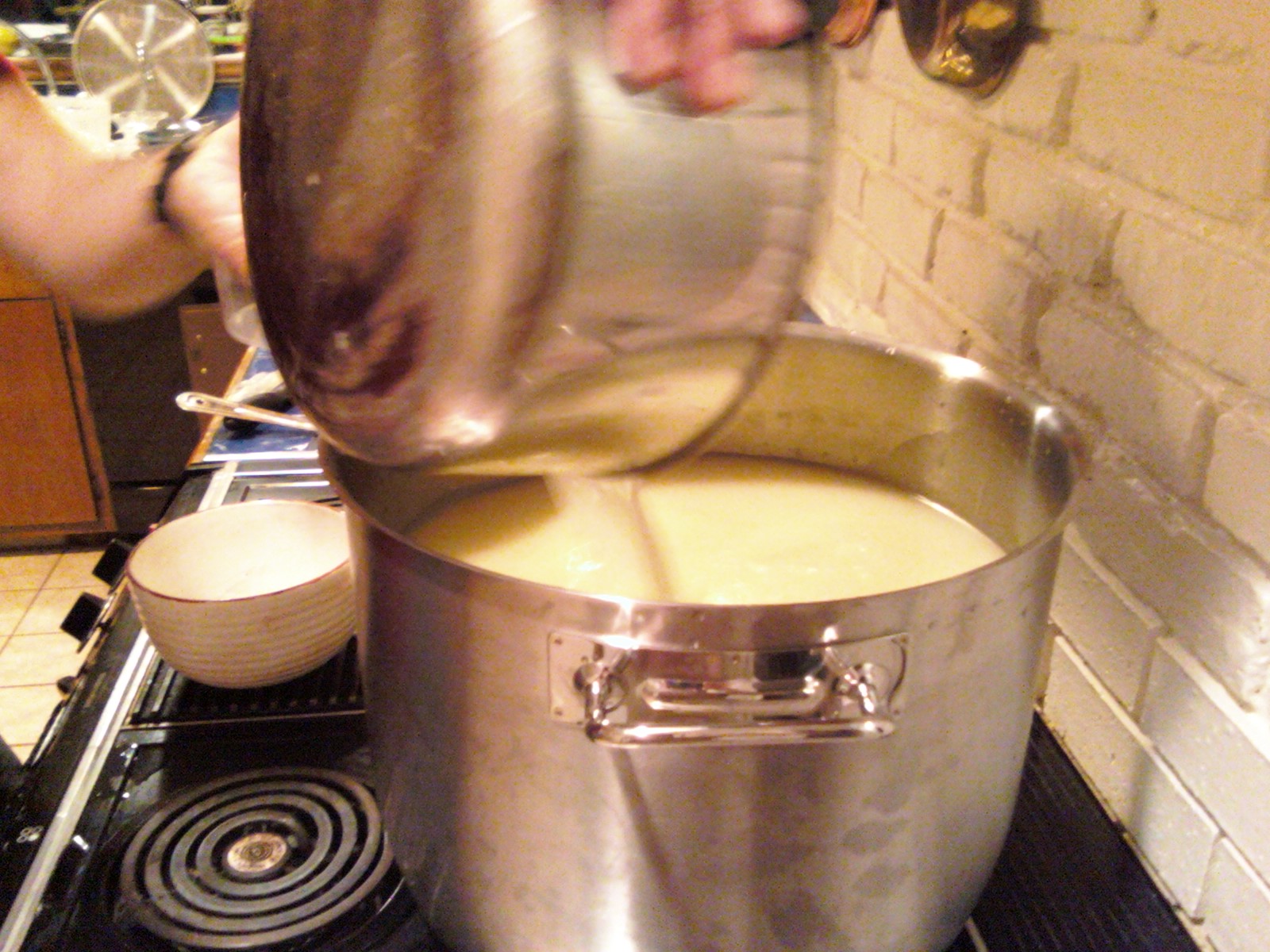|
Site.SideBar
|
?3/15/9?
- I made mysost for the first time after my second attempt at making mozzarella (and then ricotta from the whey).
- I did not boil it down nearly enough. It was very light yellow and liquid. I put it in molds and it stayed perfectly liquid, but it was still very good for spreading on toast. Mmmmm.
?4/15/9?
- T and I made mysost. We made it in a wide fry pan from the remains of farm fresh milk, that we used to make cheddar, then used the whey to make a small amount of ricotta. We kept at it until it was really really thick, and getting solid. It was still yellowish. We put it in a mold wrapped in plastic wrap. It came out grainy and pretty solid. Cutting it generally made slivers and pieces that broke apart (as opposed to making a nice slice). This worked fine - we just ate the pieces, and it tasted very good.
5/18/9
- I made Mysost using whey leftover from feta almost a week ago. I did NOT make ricotta out of it first.
- I used a little bit of heavy cream
- I followed the book's recipe
- I used the dutch oven, then transferred to a small saucepan when it started getting low. This worked very well, much better than using a wide-bottomed pan, because it allows a taller mass to reduce more evenly.
- I considered the mysost to be finished when it had reduced to a thick brown sludge. Bubbles were struggling to form at the surface, because it was a slow mass. It was still was a liquid, although it was pretty thick. I put it in a ramekin that I sprayed with a little oil. It will be interesting to see if it remains a sludge, or if it will solidify at all in the refrigerator.
- After refrigerating over night, the Mysost became much more solid(ish). It looked a lot like taffy, or specifically Mary Jane candy (only it was a bit more smooth and creamy and not quite as solid as candy).
- Getting it out of the mold involved cutting around the sides with a knife and pulling out the hockey puck. To reshape it, I mashed it back into the mold in wrapped in waxed paper, which I might should have done the first time around, although I really need to figure out a proper way to do a mold for this cheese.

The final product is absolutely creamy and delicious, and much better than my previous attempts (although it might be a bit of an acquired taste, because it doesn't taste quite like anything I've ever eaten before).
5/20/09
- I'm making mysost again from the whey from making cheddar w/1 gallon of Stewart's milk. This time I added calcium chloride to the milk, and I used mesophilic starter.
- Using a candy thermometer, I kept some track of the temperature as the whey boiled down.
4/24/10
- I'm making mysost from the whey leftover after making cheddar w/1 gallon of unpastuerized milk, yogurt starter, no calcium chloride. The milk was from Ballston Spa.
- I used the mysost recipe from Ricky Carroll's book, with cream (although not the full amount of cream because I didn't have a full cup). Her recipe is spot-on. There are two steps that I believe are very important. I have skipped these steps in the past and the result (as suggested) has been a grainy, crystalline texture. By following the steps, the resulting mysost is really nice and creamy. It forms in to a solid, almost like play-doh and is the perfect spreading texture almost like peanut butter only a bit more solid.
- Important step 1) As thickening starts on the stovetop, transfer the liquid to the blender. Blend and retun back to the pan on the stove.
- Important step 2) At the end of the process, cool the mixture down by setting the pan in water.
- The one area that's a little fuzzy is when to stop boiling the mixture down. The instructions tend to say, "it's done when it's the consistency of fudge". I have no idea what that means. I made it this time and it came out great. I would say that ideally it would be a little less solid which means that I would reduce it a little bit less next time. Here's what I saw:
- The whey starts out white, and over lots of time thickens and becomes yellow. As it starts darkening a little bit beyond yellow, it's almost ready.
- The whey started to thicken. I noticed that when you picked it up with the whisk and let it drizzle back into the pot, it would hold it's shape just a little bit on the surface (ribbons?). Almost like soft peaks forming when you lifted the mysost. I kept boiling it down at this point, but I think I should have taken it out when this started happening, or maybe a little sooner: from previous successful attempt - ("I considered the mysost to be finished when it had reduced to a thick brown sludge. Bubbles were struggling to form at the surface, because it was a slow mass. It was still was a liquid, although it was pretty thick.")
- The resulting mysost overfilled a red ramekin. I sprayed it with non-stick cooking spray before packing in the mysost. I put it in the fridge the next morning. To get the mysost out, I cut around the ramekin with a butter knife, and by the time I got 1/4 of the way around with the knife, the hockey puck popped out. I wrapped it in waxed paper.
- Starting off:

5/14/2010
- We made mesost after making feta and blue cheese from 6 gallons of goats and cows milk. It took like 12 hours to boil. There were a lot of milk solids (ricotta cheese perhaps) that boiled out of the whey. I scooped out the solids at the beginning, and re-added half of them at the end. The mesost got dark more quickly. I think that by adding the solids back in, it scorched more easily giving it a "dark" flavor. I think I prefer a slightly "lighter" flavor. Next time, perhaps it would make sense to make ricotta first to extract the solids, and then make mesost. The steam collected and deposited a bit of nasty liquid above the stove and on the ceiling, because the pot we used was too big for the fan to expel the steam. Towards the end, I added buttermilk instead of heavy cream because that is what I had on-hand. There were too many little differences this time for me to tell if the buttermilk made any difference, although it didn't seem to ruin it by any means. By the time it was finally done, I was burnt out on the cheese idea, and was a little bit lazy when cooling the mesost, and it came out grainy. It could probably have been repaired by reheating and then cooling it quickly, but as I said I'd had enough. We made a large round (a little smaller than a typical pie). It's not good on it's own because of the graininess, but I spread it on bread and put it in the toaster oven and it is very good that way.


|







